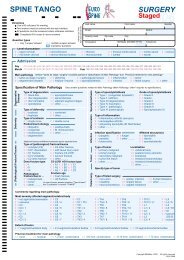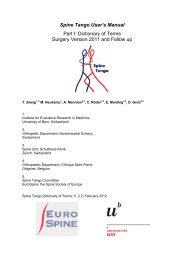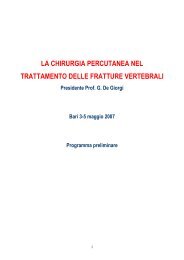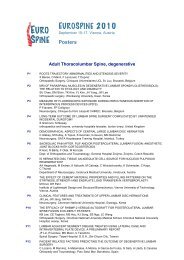Lumbar facet joint IMAGING
Lumbar facet joint IMAGING
Lumbar facet joint IMAGING
Create successful ePaper yourself
Turn your PDF publications into a flip-book with our unique Google optimized e-Paper software.
<strong>Lumbar</strong> <strong>facet</strong> <strong>joint</strong> effusion on<br />
MRI: a sign of instability in<br />
degenerative<br />
spondylolysthesis?<br />
F Lattig*, D Grob~, F Kleinstück~,<br />
T Fekete~, F Porchet~, AF Mannion~<br />
* Department of Orthopaedics, , University Medical Center, Göttingen, G<br />
Germany<br />
~ Spine Center, Schulthess Klinik, Zürich, Z<br />
Switzerland<br />
Contact address: : Friederike Lattig, MD<br />
Consultant Spinal Surgery<br />
Robert-Koch-Strasse 40, 37075 Göttingen, G<br />
Germany<br />
e-mail: friederike.lattig@med.uni-goettingen.de
Introduction<br />
Facet <strong>joint</strong> effusion is often observed<br />
on supine MRI of patients with<br />
degenerative spondylolisthesis (DS),<br />
but not in all.<br />
This sign was investigated as a<br />
possible indicator for instability in DS<br />
and rotational translation (RT).
Questions<br />
Is the degree of distension of <strong>facet</strong> <strong>joint</strong>s<br />
seen on MRI correlated with the degree of<br />
segmental mobility when comparing<br />
standing and lying positions?<br />
Is unilateral <strong>facet</strong> <strong>joint</strong> effusion, or a<br />
notable difference in the degree of<br />
effusion between right and left <strong>joint</strong>s,<br />
associated with rotational translation?
Patients<br />
160 patients that had undergone<br />
surgery for DS were identified<br />
retrospectively from our spine surgery<br />
database (collected<br />
in connection with<br />
Spine Tango)<br />
All patients had preoperative upright<br />
ap and lateral x-rays and supine MRI<br />
of the lumbar spine
Methods<br />
Imaging studies were assessed for<br />
the following parameters:<br />
- percent of slippage<br />
- absolute value of <strong>facet</strong> <strong>joint</strong> effusion<br />
- <strong>facet</strong> angles<br />
- degree of <strong>facet</strong> degeneration<br />
- degree of spinal canal narrowing<br />
- disc height<br />
- presence of rotational translation<br />
- presence of <strong>facet</strong> cysts
Results I<br />
160 patients (119 female, , 41 male) fulfilled the study<br />
admission criteria<br />
Mean age 68.8y (range(<br />
38.8 to 89.3y)<br />
Patients were divided into two groups based on the<br />
percentage slip difference between upright and supine<br />
positions: ≤ 3% (N=52) or > 3% (N=108)<br />
All 108 patients with a slip difference >3% had <strong>facet</strong><br />
effusion; 40/52 (77%) with a slip difference ≤3% had no<br />
<strong>facet</strong> effusion<br />
Percentage slip difference<br />
between upright and<br />
supine positions ≤3%<br />
Percentage slip difference<br />
>3%<br />
Facet <strong>joint</strong><br />
effusion positive<br />
N = 12<br />
N = 108<br />
Facet <strong>joint</strong><br />
effusion negative<br />
N =40<br />
N = 0
Results II<br />
As the table below shows, the group with a % slip difference between<br />
MRI and X-ray of more than 3% showed a significantly higher mean <strong>joint</strong><br />
effusion (p=0.0001), whereas the mean disc height and the percentage<br />
slip in X-ray were similar in the two groups.<br />
Difference % slip MRI-<br />
X-ray ≤3% (N=52)<br />
Difference % slip<br />
MRI-X-ray >3% (N=108)<br />
p value<br />
Age (yrs) (mean (SD))<br />
72.0 (7.4)<br />
68.7 (9.9)<br />
0.04<br />
Gender m:f (number, %)<br />
15:37 (29%:71%)<br />
26:82 (24%:76%)<br />
0.52<br />
Difference % slip MRI-X-ray (mean (SD))<br />
1.6 (1.2)<br />
10.4 (4.6)<br />
Results III<br />
In the 108 patients with a percentage slip difference >3% between MRI<br />
and X-ray, there was a significant correlation between <strong>facet</strong> effusion<br />
(mm) and percentage difference in slippage between MRI and X-ray (%)<br />
(r= 0.63, p < 0.05).<br />
35.0<br />
30.0<br />
y = 3.4945x + 2.9826<br />
R 2 = 0.4108<br />
% difference MRI-x-ray<br />
25.0<br />
20.0<br />
15.0<br />
10.0<br />
5.0<br />
0.0<br />
0.0 1.0 2.0 3.0 4.0 5.0 6.0<br />
mm effusion
Results IV<br />
As shown in the graph below, in the group of 108 patients<br />
with more than 3% difference in slippage, patients with<br />
rotatory translation (n=52, dark grey) showed greater <strong>facet</strong><br />
<strong>joint</strong> effusion differences between right and left sides (in mm)<br />
compared with those without rotatory translation (n=56, light<br />
grey) (p
Conclusion<br />
Facet <strong>joint</strong> effusion is clearly correlated with<br />
spontaneous reduction of the extent of<br />
slippage in the supine position compared to<br />
the upright position.<br />
The greater the difference in right and left<br />
<strong>facet</strong> effusion, the higher the likelihood of<br />
having RT instability.<br />
Hence, <strong>facet</strong> <strong>joint</strong> effusion could be a sign of<br />
segmental instability in DS and RT, and<br />
might help in decision-making, when<br />
considering whether to perform a fusion in<br />
addition to decompression.

















